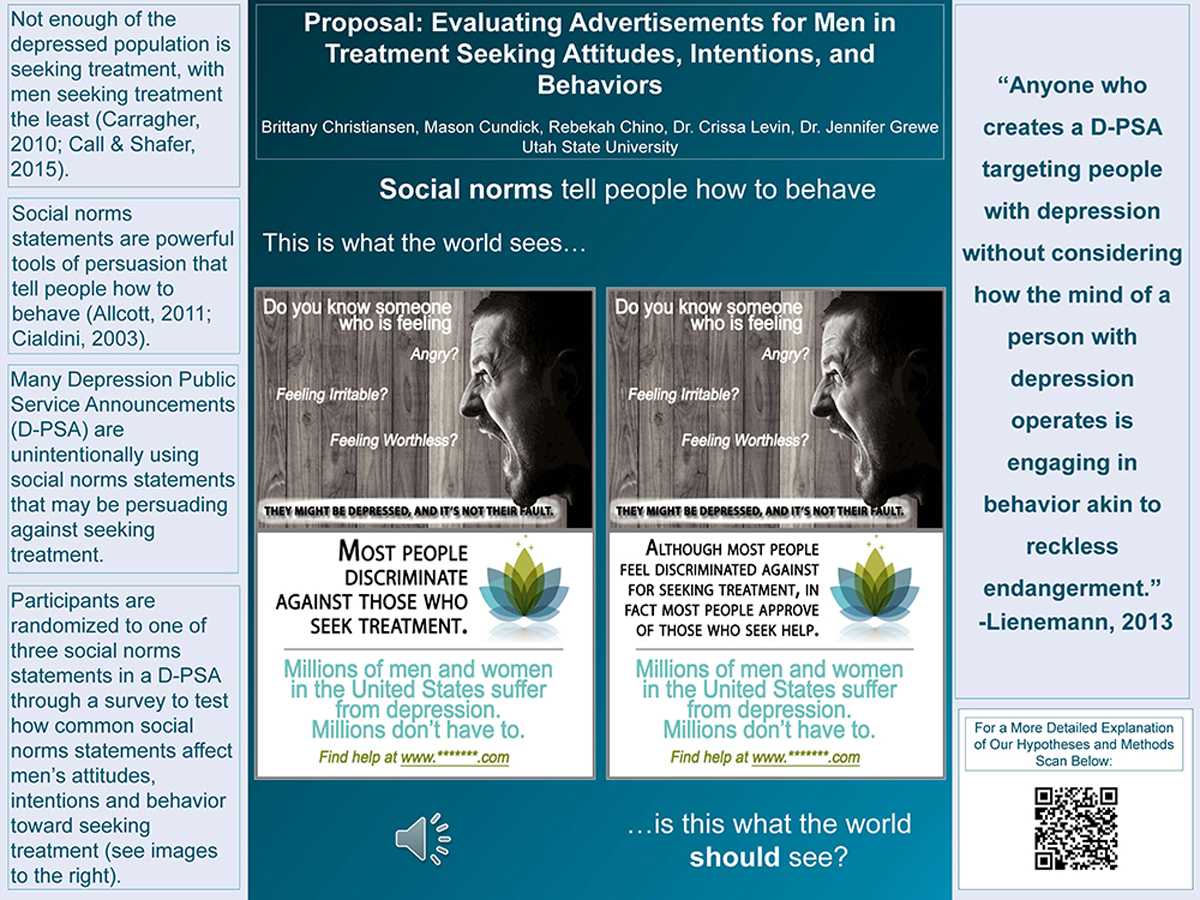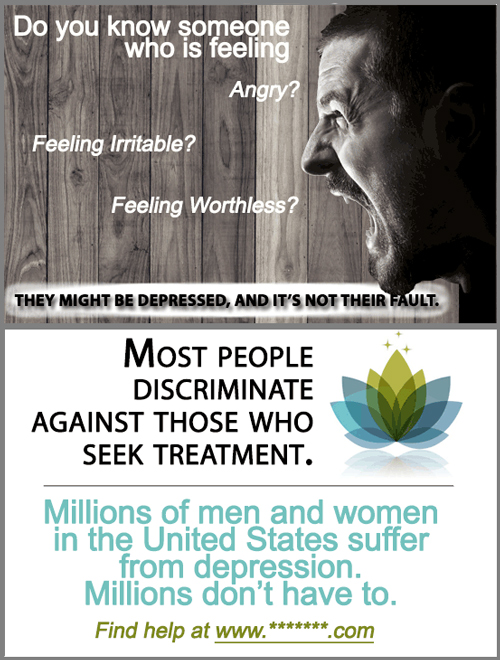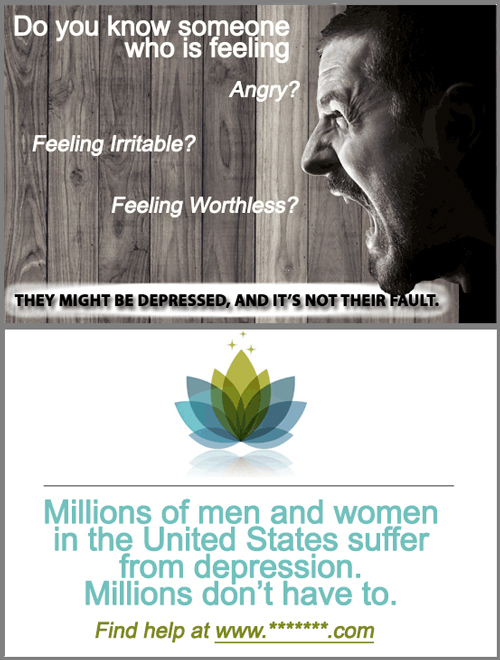Evaluating Advertisements for Men in Treatment-Seeking Attitudes, Intentions and Behaviors

Abstract
Depression is a common mental illness, affecting more than 264 million people globally (WHO, 2020). Research suggests that evidence-based treatments, including web-based therapy, can help alleviate depression (DeRubeis et al., 2005; Levin et al., 2020). However, only approximately half of people with depression seek professional help (Carragher et al., 2010), with men seeking treatment less often (Call & Shafer, 2015; NIMH, 2017). Educating the public regarding issues of mental health has been shown to change attitudes (Jorm et al., 2006; Dumesnil & Verger, 2009), however this has not been met with change in treatment-seeking behavior (Christensen et al, 2006; Reavley et al., 2014). Some public service announcements (PSAs) that intended to persuade depressed individuals to seek treatment have unintentionally used known persuasive messages of social norms which may have inadvertently persuaded said individuals away from seeking treatment (Lienemann et al., 2013; Levin, Papa & Levin, in preparation). These social norm statements involve only a few words to influence people to behave as most others behave, or to behave in ways that most people would approve (Allcott, 2011; Cialdini, 2003). Depression PSAs sometimes note things like “most people do not seek treatment” as a way to normalize and encourage treatment seeking behavior, but this may in fact be a strong persuasive message against seeking treatment. For example, on the National Institute of Mental Health’s website, it states that “men are less likely than women to recognize, talk about, and seek treatment for depression” and “men may turn to drugs or alcohol to cope with their emotional symptoms'' (NIHM, 2017). We hypothesize that using commonly used anti-norm statements in public outreach materials to encourage men to seek treatment may actually decrease initial treatment-seeking behaviors, reduce positive attitudes about seeking treatment, and reduce intentions to seek treatment.
Evaluating Advertisements for Men in Treatment-Seeking Attitudes, Intentions and Behaviors
Hypotheses
- Men will differentially respond to the anti-norm compared to the other two conditions, such that they will be less likely to engage in help seeking behaviors, intentions, and have less positive treatment seeking attitudes.
- (Anti-norm) “Most people discriminate against those who seek treatment.”
- (Combined) “Although most people feel discriminated against for seeking treatment, in fact most people approve of those who seek treatment.”
- (Control) No text
- Men with higher depression will show an overall lower behavior of seeking treatment, lower intentions, and lower positive attitudes about seeking treatment.
- Men with depression will show differential increases in treatment seeking in all three treatment variables when presented with combined norms and control compared to anti-norms.
Methods
Recruit participants through SONA: Participants will be recruited from USU via the SONA system. SONA will direct them to our Qualtrics survey, where we are offering .5 SONA credits for completion.
Qualtrics Survey
Explanation of deception: The survey begins with deceptive instructions saying we are looking at demographics and basic health information to see how it interacts with depression outreach materials for a market research study. Really, this is just to mask our baseline question on intention to seek treatment for depression- which is a single question asking if they thought they had depression, to what degree would they seek treatment?
PSA: They will then view a Depression Public Service Announcement (D-PSA) for seeking treatment. The D-PSA is randomly generated between three different ads that have the same information other than the social norm statement. The two D-PSAs you see on our poster contain two different social norm statements. The other D-PSA is the control that does not include any social norm statement.



Manipulation check: After seeing the D-PSA, participants can indicate what they liked/disliked about it (which might make for interesting post-hoc analysis), and they will get a question about what was on the ad. If they answer it incorrectly, their data will be excluded from data analysis.
Assessments: Participants will then be asked to complete a few assessments. The first is Attitudes Towards Seeking Professional Help Scale- Short Form, which will give us a measure for attitudes about seeking treatment. Next is a measure for depression with the Center for Epidemiologic Studies for Depression Scale- Revised. At this point, they will receive the same question they received at baseline regarding intention to seek treatment for depression. Lastly, they will be given the option to open a new browser tab connecting them to USU’s ACT Guide, which is a web-based treatment for mental health, giving us a measure of initial treatment seeking behavior. Please click the following link to be directed to ACT Guide: https://scce.usu.edu/services/act-guide/
Data Analysis
- We will use MANCOVA to analyze group differences in intentions to seek treatment and attitudes about seeking treatment while accounting for depression as a covariate.
- Chi-square tests will be used to analyze whether there were differences in treatment seeking behavior (clicking the link to ACT Guide) between groups.
- Linear regression analysis will be used to look at each of the three treatment seeking variables (Behavior, Attitudes, and Intentions) individually as they relate to each PSA condition.
Limitations
- Using college students as the sample participants had benefits of providing free therapy, obviating a common barrier to treatment. However it also created a limitation because it challenges generalizability and validity as they are considered a homogenous group with their similar age, socioeconomic status and education levels.
Psychology departments often have a research participant requirement or give extra credit or general credit for participating in research. The concern is that psychology students represent a majority of student participant pools and psychology students score higher on positive attitudes toward seeking professional psychological help (citation) which poses the question of whether that is really representative of the general public.
Debriefing
Protocol #10763
Thank you for your participation in this study. Now that you have completed the entire survey, we want to let you know that we have not been entirely honest with you about the study’s purpose, or about some of the information you may have seen in the brief advertisement you viewed.
The purpose of this study is to better understand if the attitudes and plans to seek services were changed by the exposure to the ad. We were testing a few persuasion principles to see if there were ways to make a message promoting treatment-seeking for depression have more reach and help more people. One thing we were looking at was based on the idea that often people who know they are being persuaded are more resistant to persuasion and more skeptical of the message, so we were a little bit indirect about the fact that we were trying to persuade you.
The other principle we were looking at was whether different "social norms" statements (statements about what other people do or of what other people approve of) would be more or less powerful in this type of advertising. There is a lot of research to suggest that telling people "most people approve of treatment,” would make people more willing and interested in seeking treatment, and yet most of the advertising out there right now says the opposite. Some of you got an advertisement that had this message, but some of you got a very different message - that most people are stigmatized for seeking treatment. So you can see that to test this question, we ultimately had to lie to some participants. The truth is, the data suggests that approving of seeking help is far less common, and it appears that it's unfortunately quite common for people seeking psychological help to be stigmatized, looked down upon, and treated poorly for having sought treatment (Barney, Griffiths, Jorm, & Christensen, 2006; Ben-Porath, 2002; Kelly & Jorm, 2007).
We hid a question in the survey that related to our study in between other unrelated questions. The question was posed as demographics information when it was really intended to get a baseline to compare attitudes before seeing the advertisements. This was done so that you would not become aware of our true focus, while we attempt to see if your initial intention to seek treatment changed after you viewed our “social norms” statements.
The reason why it was important to test this question (and therefore lie to you) is because the rest of the ad was true - many people suffer from depression, and treatment for depression really can be very helpful - but far fewer people seek treatment for depression than we would hope. We're hoping to find ways to reach out to the public more effectively, and hopefully increase the number of people who seek treatment that might benefit from psychological help.
Now that you are informed of the true objectives of this study, you have the option to withdraw your participation.
If you feel concerned about this study or your participation, please feel free to contact Crissa Levin Ph.D. at (385) 313-8326 or crissa.levin@usu.edu, or the Utah State University Research Integrity Office at 435-797-0186; compliance@usu.edu. If you would like to receive help for a mental health issue, please take advantage of the free online resource: Act Guide, the link is provided in the survey or you can go to https://scce.usu.edu/services/act-guide/. If you are in a crisis or have any thoughts of harming yourself, the National Hope line Center is available 24/7 by calling 1-800-SUICIDE (1-800-784-2433).

